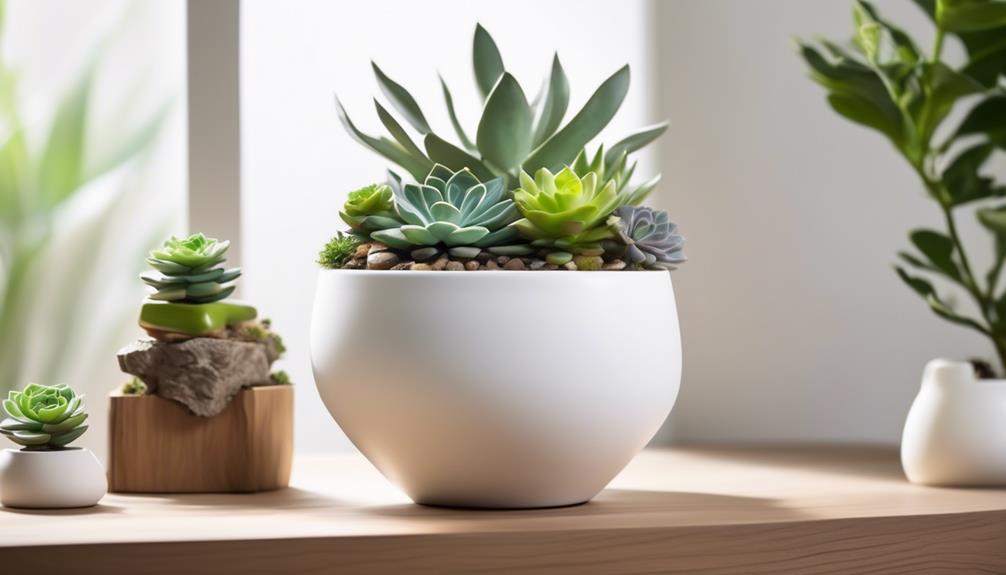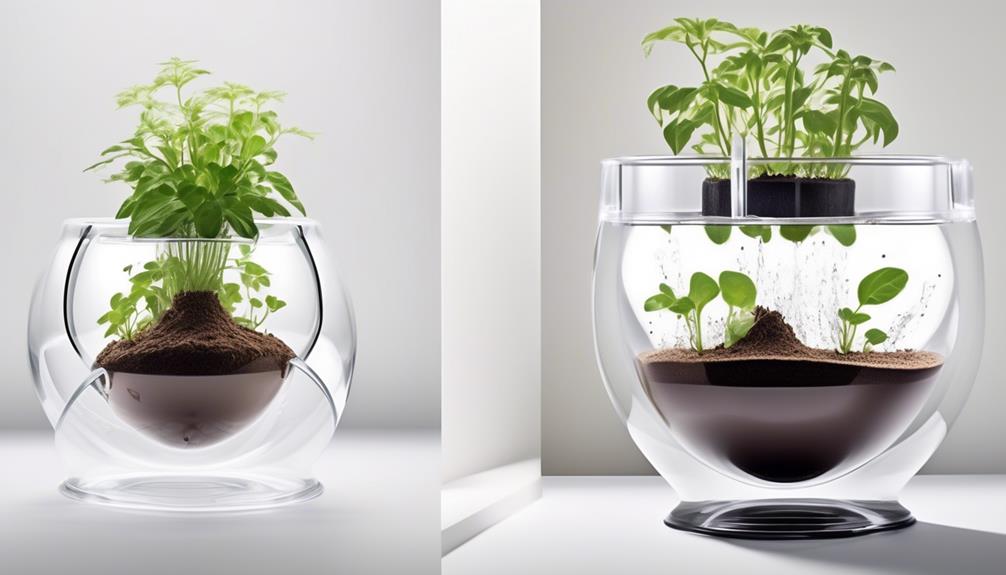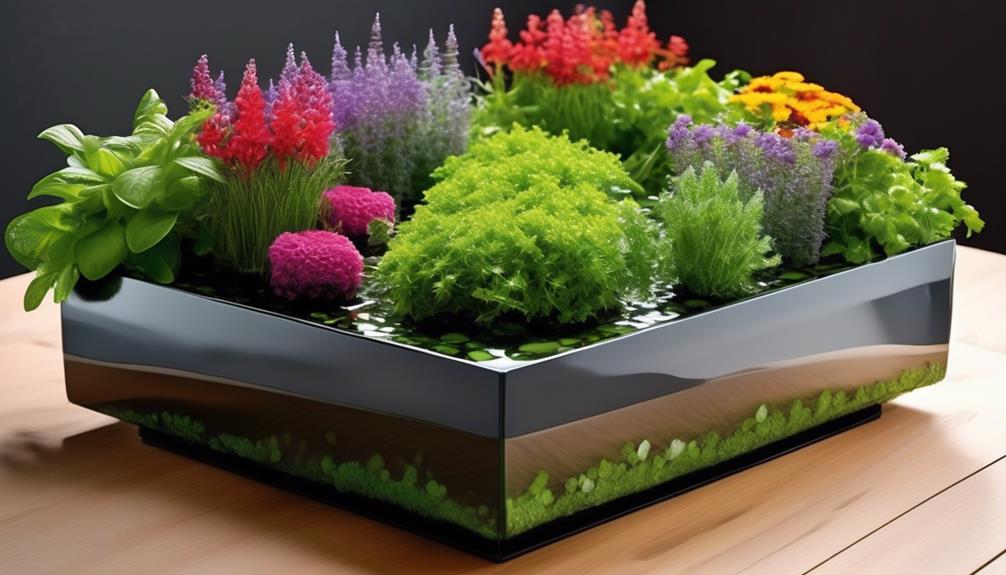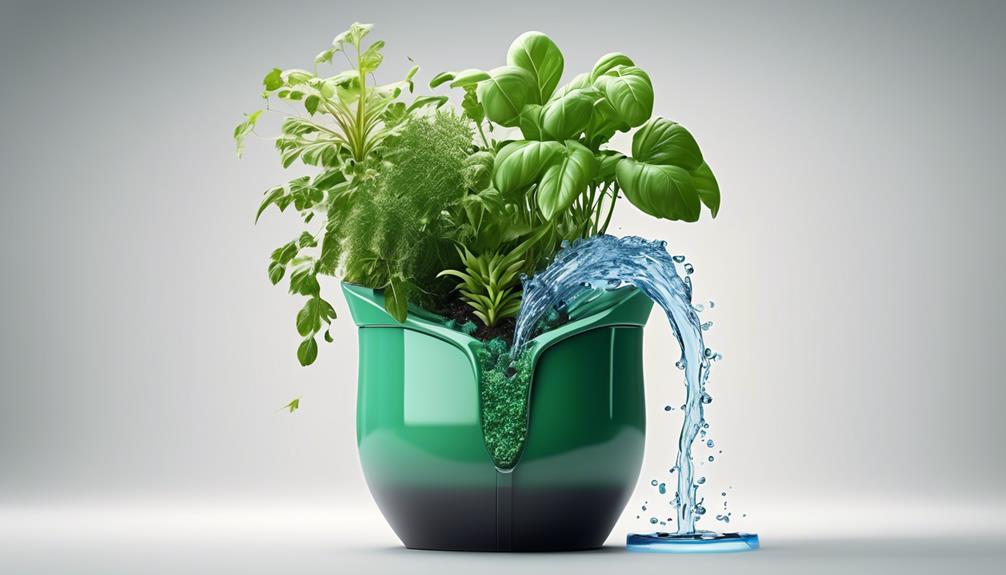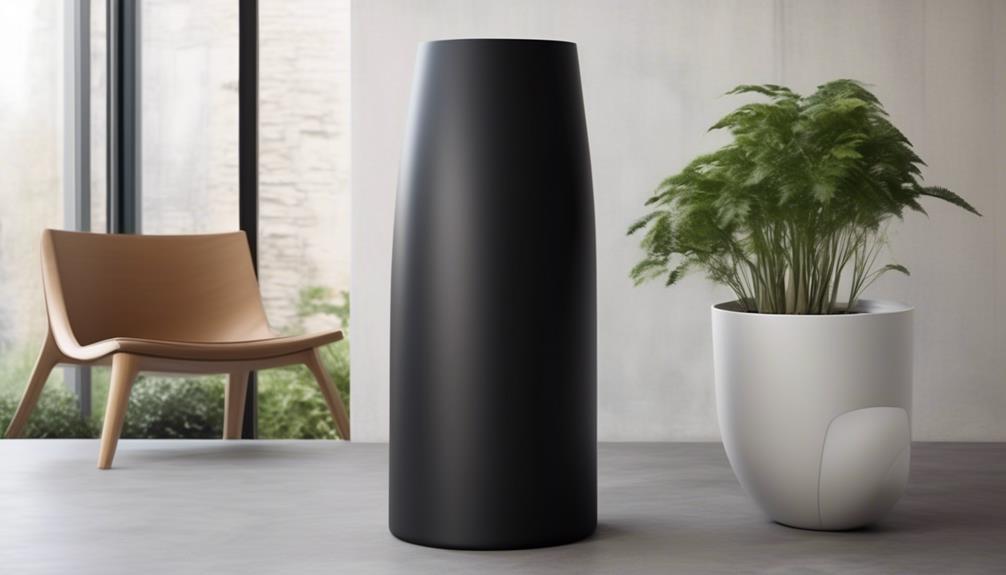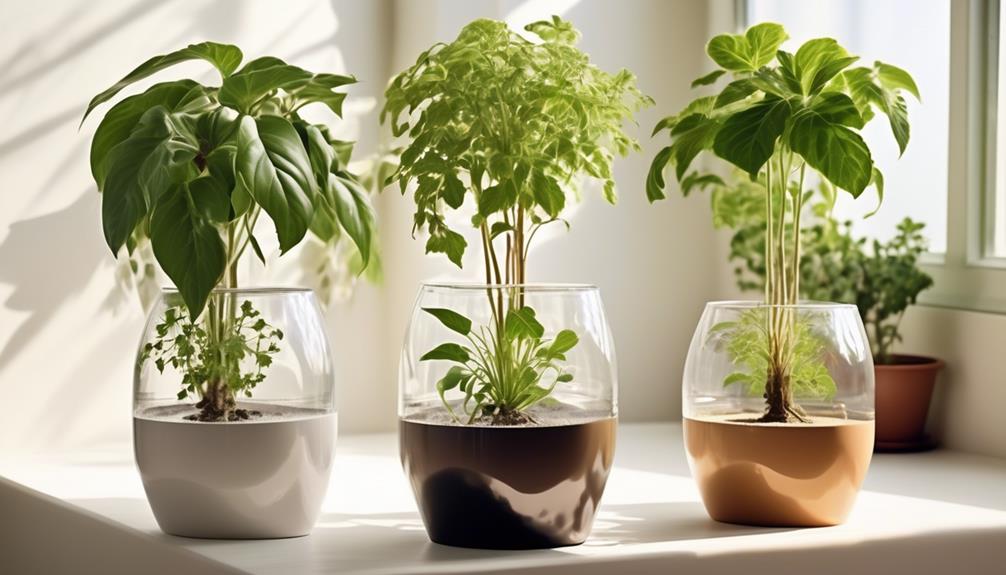We have all experienced the challenge of making sure our plants get adequate water, especially when our busy schedules take priority.
But what if I told you there's a way to make this task a bit more effortless? Self-watering ceramic plant pots have been gaining attention for their ability to maintain optimal moisture levels for plants, requiring less frequent attention from us.
But before you dismiss them as just another trendy gimmick, there's more to these pots than meets the eye. Let's explore how these innovative containers could be a game-changer for both experienced and novice plant parents alike.
Key Takeaways
- Self-watering ceramic pots are a convenient and efficient way to maintain optimal soil moisture levels for plants.
- Choosing the right pot size is crucial for healthy plant growth and proper drainage.
- Understanding the watering system of self-watering pots helps in making informed decisions for plant care.
- Regularly monitoring soil moisture levels and inspecting roots are essential for the well-being of plants in self-watering pots.
Benefits of Self-Watering Ceramic Pots
Self-watering ceramic pots offer a convenient and efficient way to maintain optimal soil moisture levels for plants. These pots provide long term benefits by ensuring that plants receive consistent hydration, reducing the risk of under or overwatering. This convenience is especially valuable for those who may have busy schedules or are inexperienced in plant care. The self-watering feature helps to create a stable growing environment for plants, promoting healthier root systems and overall plant growth.
In addition to the practical advantages, self-watering ceramic pots also have a positive environmental impact. They contribute to water conservation by minimizing wastage. The design of these pots prevents water from evaporating quickly, meaning less water is required for plant maintenance. This not only benefits the user by reducing the frequency of watering but also aligns with sustainable practices. By conserving water, these pots support efforts to reduce water usage and promote environmentally friendly gardening practices.
Choosing the Right Pot Size
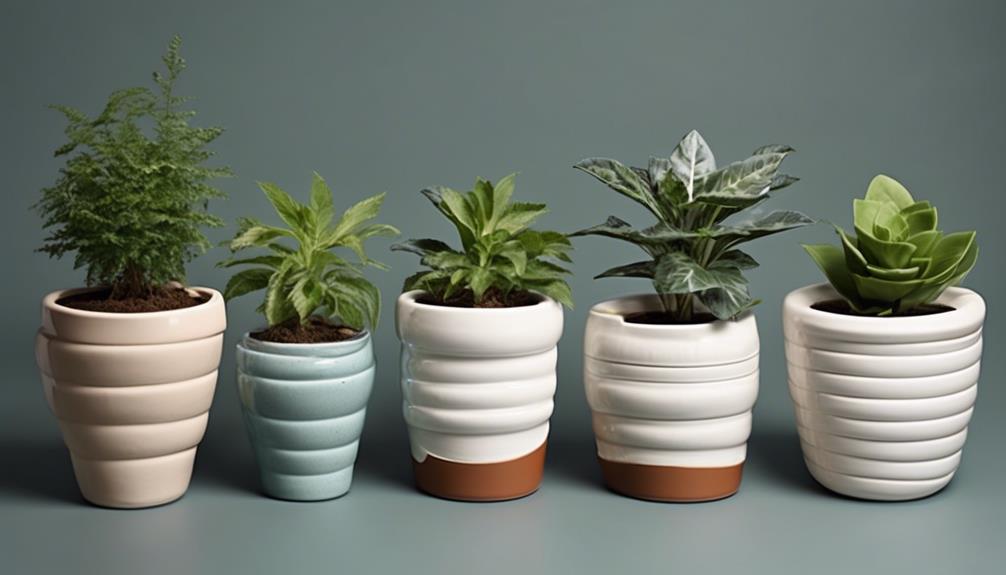
After discussing the benefits of self-watering ceramic pots, it becomes essential to consider the appropriate pot size for ensuring the optimal growth and health of the plants. Choosing the right pot size is crucial for maintaining proper drainage, promoting healthy root development, and ensuring plant compatibility.
Here are some key factors to consider when selecting the right pot size:
- Root Space: Adequate space for the plant's roots is essential for healthy growth. A pot that's too small can restrict root development, leading to stunted growth and poor nutrient uptake.
- Moisture Retention: The pot size should be proportional to the plant's water needs. A larger pot retains more moisture, which can be beneficial for plants that require consistently moist soil. However, overwatering can lead to root rot if the pot is too large for the plant's needs.
- Plant Size: The pot size should be proportionate to the size of the plant. A small plant in a large pot may struggle to absorb water efficiently, while a large plant in a small pot may become root-bound.
- Aesthetic Considerations: The pot size should also complement the overall aesthetic of the plant and its surroundings, enhancing the visual appeal of the space while providing ample room for growth.
Choosing the right pot size involves careful consideration of various factors to ensure the overall health and vitality of the plant.
Understanding the Watering System
Understanding the watering system involves analyzing the distribution of water within the pot and its interaction with the plant's roots. It's crucial to comprehend the dynamics of how the self-watering system functions to ensure the optimal growth of your plants. The table below provides a clear comparison of the watering frequency and the necessity of replacing wicks in traditional watering systems versus self-watering ceramic pots.
| Aspect | Traditional Watering | Self-Watering Ceramic Pots |
|---|---|---|
| Watering Frequency | Daily or as needed | Every 1-2 weeks |
| Replacing Wicks | Not applicable | Every 4-6 months |
In traditional watering systems, plants often require daily or as-needed watering, leading to a higher maintenance demand. Conversely, self-watering ceramic pots significantly reduce the frequency of watering, typically needing attention only once every 1-2 weeks. Additionally, the need to replace wicks is non-existent in traditional systems, while self-watering pots require wick replacements every 4-6 months to ensure optimal functionality. Understanding the watering system's nuances empowers us to make informed decisions to serve the needs of our plants efficiently.
Tips for Plant Care in Self-Watering Pots
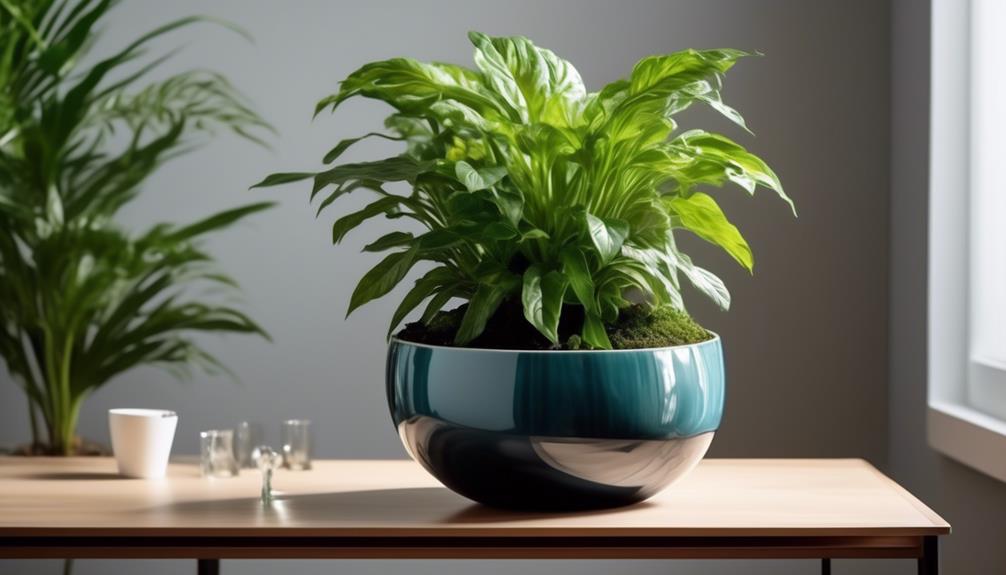
When caring for plants in self-watering pots, it's essential to monitor the soil moisture levels regularly to ensure optimal growth and health. Proper plant placement and watering frequency are crucial for the well-being of your plants.
Here are some tips for plant care in self-watering pots:
- Plant Placement: Ensure that the plants are placed in an area where they receive adequate sunlight based on their specific light requirements. This will help in maintaining the overall health and vigor of the plants.
- Watering Frequency: Check the soil moisture regularly and adjust the watering frequency based on the specific needs of each plant. It's important to remember that different plants have different water requirements, so adjusting the watering frequency accordingly is crucial for their health.
- Soil Moisture Monitoring: Use a soil moisture meter to regularly check the moisture levels in the pot. This will help in understanding the water needs of the plants and prevent over or under-watering, which can impact root health.
- Root Health: Regularly inspect the roots of the plants to ensure they're healthy and not waterlogged. Proper soil moisture levels are essential for the overall well-being of the roots and the plant as a whole.
Incorporating Self-Watering Pots Into Your Decor
Incorporating self-watering pots into your home decor enhances the aesthetic appeal while providing a functional and practical solution for maintaining healthy plants. When considering innovative designs for interior styling, self-watering pots offer a seamless way to integrate greenery into any space.
These pots come in a variety of materials, shapes, and colors, allowing for versatile incorporation into different decor themes. For instance, sleek and modern self-watering pots can complement a contemporary interior, while rustic terracotta pots can add a touch of warmth to a more traditional setting. By seamlessly blending with existing decor, self-watering pots contribute to a cohesive and harmonious atmosphere within a space.
Additionally, the convenience of self-watering pots ensures that the plants receive the right amount of hydration, even when attention is divided among various household tasks. This functional aspect of self-watering pots aligns with the desire to serve others by providing a low-maintenance solution for plant care within the home.
Frequently Asked Questions
Can Self-Watering Ceramic Pots Be Used for All Types of Plants, Including Succulents and Cacti?
Yes, self-watering ceramic pots can be suitable for various types of plants, including succulents and cacti.
Succulent care involves well-draining soil and controlled watering, which self-watering pots can facilitate.
When considering plant pot materials and drainage options, it's essential to ensure that the pots allow excess water to escape, preventing overwatering and root rot.
Therefore, self-watering ceramic pots can be a viable option for succulents and cacti, especially when designed with proper drainage features.
How Often Do I Need to Refill the Water Reservoir in a Self-Watering Ceramic Pot?
We find ourselves constantly amazed at the self-watering ceramic pot's ingenious design. The refilling frequency depends on factors like plant type and environmental conditions.
A water level indicator provides visual cues for refilling. Succulents and cacti, known for drought tolerance, can thrive in these pots.
Regular monitoring ensures the reservoir doesn't run dry, promoting healthy plant growth.
Are Self-Watering Ceramic Pots Suitable for Outdoor Use, or Are They Best for Indoor Plants?
For outdoor vs indoor use, self-watering ceramic pots can work well indoors or outdoors. The benefits include consistent moisture for plants and less frequent watering. Drawbacks may include potential water stagnation in outdoor settings.
Best plants for outdoor self-watering pots are those that thrive in consistently moist soil, such as ferns, impatiens, and coleus. Consider the specific environmental conditions, like sunlight and temperature, to determine the best fit for your self-watering ceramic pots.
Can I Use Fertilizer in a Self-Watering Ceramic Pot, and if So, How Often Should I Do So?
Yes, we can use fertilizer in the self-watering ceramic pots. The frequency of fertilizing depends on the plant's growth potential and its health. Fertilizing provides essential nutrients for plant growth.
It's crucial to follow a proper fertilizing schedule to ensure optimal plant health. Over-fertilizing can lead to nutrient imbalances, affecting plant growth negatively, while under-fertilizing may hinder the plant's potential.
Therefore, understanding the specific needs of the plant is crucial for successful fertilization.
Are There Any Special Considerations for Cleaning and Maintaining Self-Watering Ceramic Pots to Prevent Mold or Mildew Buildup?
We've found that regular cleaning is crucial for preventing mold and mildew in self-watering ceramic pots. To keep them in top condition, wipe down the interior with a mixture of water and vinegar every few weeks. Scrub away any visible mold or mildew with a soft brush or cloth.
Additionally, ensure the pot's drainage system is functioning properly and avoid overwatering. These simple steps can help maintain a healthy environment for your plants.
Are Pottery Self Watering Plant Pots as Effective as Ceramic Self Watering Plant Pots?
When it comes to self watering plant pots, both pottery and ceramic options have their pros and cons. Pottery pots are porous and allow airflow, while ceramic pots provide better insulation. Both are effective, but pottery may dry out quicker. Consider your plant’s needs before making a decision.
Conclusion
In conclusion, self-watering ceramic plant pots offer numerous benefits, including convenience and improved plant health.
By choosing the right pot size, understanding the watering system, and following plant care tips, you can easily incorporate these pots into your decor while ensuring your plants thrive.
With self-watering pots, you can save time and effort while enjoying the beauty of healthy, well-maintained plants in your home.

